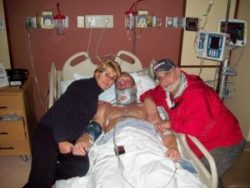Delaney Unger was diagnosed with osteosarcoma, which accounts for about 800 to 900 cases annually in the United States with about half occurring among children and teens.
She also underwent an exceptionally rare form of surgery that consumed 13 hours in April 2017. Not only did she undergo an amputation of a small portion of her thigh bone and all of her knee, her ankle and foot were rotated 180 degrees and attached to the stump of her thigh. This allowed her ankle to function as a knee.Two names are used interchangeably to define the rarely performed surgery: The Van Nes procedure and rotationplasty.
Delaney, who addressed a news conference at Stony Brook University Hospital Monday, along with her parents and doctors, tells the rest of her own extraordinary story.
“When I first heard what my options were for surgery, I knew that rotationplasty would be the best choice for me. I am a very active person. I have been dancing since I was three,” she said. “This option seemed to be the one to give me the most mobility, flexibility and allow me to live the high-impact life I was used to.
“Through social media, I was able to connect with others who had rotationplasty, and I could see the effects of the surgery firsthand,” she said.
Delaney, who will be 13 next month, received a prosthesis in October 2017, which fits over the backward-oriented foot and extends up the thigh. The colorful prosthetic has allowed her to walk, jump — and dance.
She took her prosthesis off during the news briefing to reveal the outcome of her surgery, then reattached the artificial limb revealing how quickly she straps it on.Delaney was in a dance recital in May, performing hip-hop and jazz moves. She also studies tap and ballet.
Dr. Jason Ganz, Delaney’s plastic and reconstructive surgeon, marveled Monday at his patient’s progress and declared: “You look incredible.”
Osteosarcoma is among the rarest of cancers with about 800 to 900 new cases reported annually in the United States, approximately half occurring among children and teens.
“It is a disease that with lots of teamwork can be overcome,” said Dr. Fazel Khan, an assistant professor of orthopedic surgery at Stony Brook. He performed Delaney’s rotationplasty.
Khan said the procedure dates back to the 1950s and derives one of its names from Dutch orthopedist Dr. Cornelis Pieter van Nes.“The surgery was initially developed for noncancer patients who had either tuberculosis infection or congenital limb deficiencies,” Khan said.
The ankle must be rotated 180 degrees, Khan added, because “the knee bends one way but the ankle bends the opposite way.”
Rotationplasty enhances mobility of people who depend on a prosthetic limb, Khan said, and placing the ankle joint in the position of the knee creates a functional, natural knee. The toes provide important sensory feedback to the brain, Khan said.
Melissa Unger, Delaney’s mom, said the diagnosis, treatment and surgery were difficult, but she is proud of her daughter, who has already expressed a desire to become a pediatric cancer specialist.
“Delaney has always had lots of confidence, drive and determination. All of these traits helped her to fight her battle and come through the other side,” Unger said.




